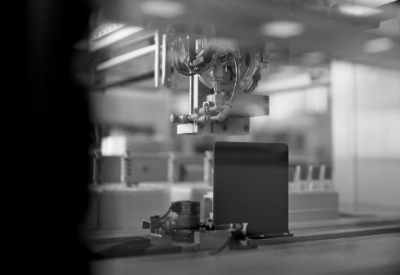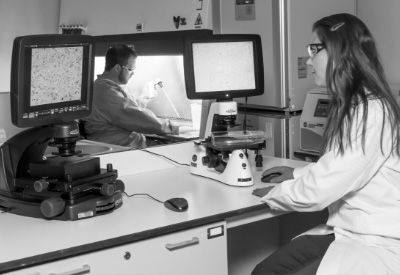
ENIAC, the first digital computer, was more than 1,800 square feet and was estimated to run about 0.00289 million instructions per second. By comparison, modern day iPhones can perform billions of instructions per second—and fit into your pocket. This evolution is due largely to the development of microelectronics.
What Is Microelectronics?
The word “microelectronics” describes a subfield of electronics that focuses on microchips or tiny complex machines which allow other devices to function. As technology becomes more efficient, microelectronics will be more and more common in everyday machines. To understand why City Labs is working to improve microelectronic batteries, let’s explore some background on the topic.
History of Microelectronics
Moore’s Law—based on Intel co-founder Gordon Moore’s perception—observes that the speed and capability of our computers increase every few years. At the same time, the price should continue to drop, making more powerful processors accessible to more individuals. From the creation of the first integrated circuit (IC) by Jack Kilby in 1958 to the first microprocessor developed by Intel in 1971, we’ve come a long way.
Microelectronics vs. Traditional Electronics
It’s no secret that the primary difference between microelectronic devices and normal electronic devices is their size. Microprocessors are normal processors, but smaller. To be more specific, microelectronics encompasses electronic components with nominal feature sizes between 100 and 0.1 micrometers in magnitude. Components smaller than 0.1 micrometers (or 100 nanometers) are considered nanoelectronic devices.

How Do Microelectronic Devices Work?
To understand how microelectronic devices function, you must also understand the role of a transistor. Transistors are basic electronic components that can alter the flow of electrical current. Think of them as a gatekeeper for electronic signals, constantly regulating the current’s flow. Transistors switching on and off create Boolean operations through a series of 1s and 0s. Microelectronic devices keep track of these values to create larger, more complex pools of data.
A series of several transistors connected to a microprocessor can process hundreds of billions of information bits in mere seconds.
Examples of Microelectronic Devices
Microelectronics is not just about small devices, it’s also about small devices that perform some task with electricity. Here are some of the common microelectronic devices you may be familiar with (or surrounded by).
Medical Devices
As medical technology progresses, so does the desire to make it more convenient. A device that allows a deaf person to hear is not practical if it is the size of an elephant. Ideally, a medical device could solve a patient’s issue without the patient (or anyone else) noticing it.
This is one reason that microelectronic devices are becoming more popular in the medical field. Hearing aids, pacemakers, defibrillators, and other machines are continuing to get smaller and more effective.
Power Sensors
Power sensors are small devices that can measure electronic characteristics, such as current, power, and voltage. They can be used to monitor certain systems from afar in case additional actions are necessary. The added security of power sensors prevents large mishaps by identifying issues before they get out of hand.
Radio Frequency Identification
Radio Frequency Identification, or RFID, is a wireless technology that uses electromagnetic fields to detect and track tags attached to particular objects.
RFID systems comprise a transponder, radio receiver, and radio transmitter. When a tag is activated by an electromagnetic pulse from a nearby RFID reader, it will send digital data to the host in the form of an inventory number. This number helps identify the tag holder and records an exchange or grants clearance.
Similar technology was used to identify whether aircrafts were friend or foe during World War II. Over the last few decades, however, the use of RFIDs in microelectronics has exploded into every industry. Healthcare can use these tags for contactless testing, they are in vehicles for security identification purposes, and more.
One of the most common uses of RFID systems is contactless payment. Phones and credit cards use an evolved version of RFID called Near-Field Communication (NFC) that tightens the range of the electromagnetic field. When these devices are placed in a direct line with the reader, they can transfer data and provide identification without physical contact. So if you have a small chip on one side of your credit card, go easy on it because it’s actually a microprocessor.
Microprocessors
A microprocessor is, in essence, a tiny computer. As the trademark example of a microelectronic device, these components allow us to greatly increase the computing power of more complex systems. As long as we can concurrently improve microelectronic batteries to power said processors, these small but powerful components will only continue to improve.
What Is a Microbattery?
Microprocessors, power sensors, and RFIDs all need power to function. These microelectronic devices rely on scaled power sources to provide the electricity they need. Microelectronic batteries, or microbatteries, are created in a way that allows them to take up as little space as possible. Microbatteries cause little interference to microelectronic systems because they have a small footprint and a low heat signature.
Taking Batteries Into Account for Microelectronic Engineering
Power is an essential part of any electronic device—no matter the size. Even if you are trying to build the smallest processor or chip possible, you still have to leave room for a power supply. External batteries are often embedded directly into microelectronic systems for the most reliable energy.
Applications in Microelectronics
Microelectronics has the potential to improve almost any industry. However, due to limited resources and expertise, there are certain fields in which these devices are more popular. Microelectronic technology is commonly used to make advancements in computer technology, security monitoring, medical devices, and environmental research.
The Future of Microelectronics
The rapid improvement of microelectronic technology has not slowed down. Scientists and engineers are constantly working to improve the devices we have and develop new innovations. The general goal has always been more processing power from smaller devices. Perhaps this is why many experts believe that nanotechnology is the inevitable future of microelectronics.
Michigan Micro Mote
One great example of a microelectronic device is the Michigan Micro Mote (M3). The M3 is a small machine developed by University of Michigan faculty and students. Led by Professor David Blaauw, this creation made history as the world’s tiniest computer.
Some of the betavoltaic batteries from our first series in 2008 are powering the M3 to take temperature readings of the surrounding environment, store that data, and periodically transmit it to the base station. This combination of the betavoltaic batteries and M3 can monitor temperature, vibrations, and other parameters for decades.
City Labs has also issued an NIH subcontract to Professor Blaauw’s team for a voltage down converter that can be coupled with the M3.
Limitations of Microelectronic Devices
Even though the field of microelectronics is constantly progressing, there are certain factors that slow its growth. One of these bottlenecks is the availability of small, durable batteries which can output sufficient power over long periods of time. It does not matter that an engineer can develop a power sensor with the capacity to harvest decades of data if there is no viable power source for said device.
Current electrochemical batteries are widely available, but their lifespan is often limited to a few years or less. They are also greatly dependent on environmental conditions and energy capacity. These factors affect their reliability and longevity, often to their detriment.
City Labs’ Microelectronic NanoTritium™ Batteries Last for 20+ Years
City Labs has created long-lasting NanoTritium™ betavoltaic batteries that can output sufficient power for more than two decades. As this power stems from natural decay of radioisotopic material, it occurs at a consistent and reliable rate. City Labs’ products can be used in harsh or remote environments that don’t allow for easy maintenance or replacement. If you think our batteries could benefit your scientific or commercial efforts, read more about how our technology works.
The Nuclear Battery Company With a Vision
Ready to power your next innovation or learn more about our technology?
Contact Us Today



